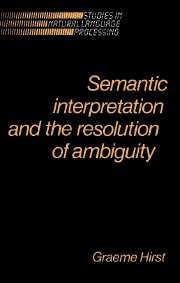Book contents
Summary
Towards a conclusion
The goal of this chapter is to put the work described in previous chapters into perspective. First, I summarize the virtues of the work, and its potential. Then I compare it with similar work carried out concurrently by others. Finally, I list some of the questions that it leaves unanswered that ought to be answered.
The work in review
What has been achieved
I have presented a semantic interpreter and two disambiguation systems: one for lexical ambiguity and one for structural ambiguity. The systems have been designed to work closely with one another and with an existing parser and knowledgerepresentation system.
The semantic interpreter, Absity, is “Montague-inspired”, in that it adapts to AI several aspects of Montague's (1973) way of thinking about semantics: it is compositional; it has a strong notion of “semantic object”; it operates in tandem with a parser; its partial results are always well-formed semantic objects; and it imposes a strong typing upon its semantic objects. The semantic objects are objects of the knowledge representation, and the types are the types that the representation permits (which, we saw, correspond to the syntactic categories of English).
The structural disambiguator is the Semantic Enquiry Desk. It tells the parser what to do whenever the parser needs semantic help to decide between two or more alternative structures. The SED makes its decisions by looking at the semantic objects in the partial results of the semantic interpreter, and, if necessary, by calling the knowledge base for information on plausibility and referential success.
- Type
- Chapter
- Information
- Semantic Interpretation and the Resolution of Ambiguity , pp. 189 - 201Publisher: Cambridge University PressPrint publication year: 1987



